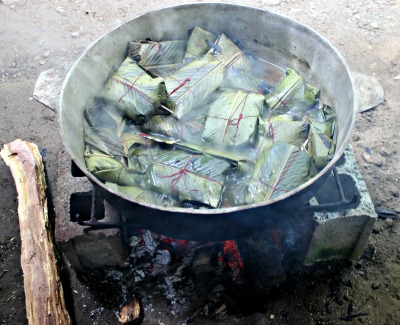
The first time I had Panamanian tamales I was under-whelmed. I had a real fondness for tamales, Mexican tamales.
Initially, I was not thrilled with the wetness of tamales in Panama. It is definitely more messy to eat than a Mexican tamale. Of course, it didn't help that whomever had made them had skimped on the chicken. It was mostly cornmeal.
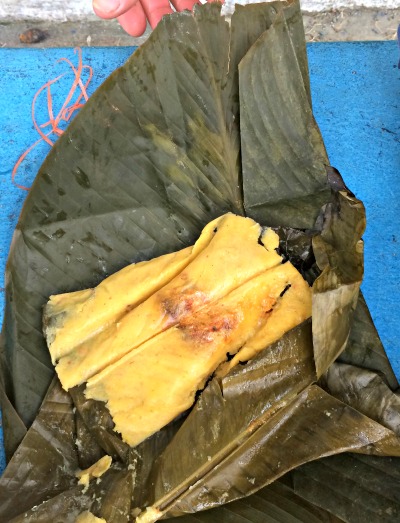
Over the years, I have grown to appreciate how much more flavor the "messy" cornmeal gives to the tamale. They cook the cornmeal in a well-spiced broth which gives it the flavor.
Now, whenever we find someone who is selling tamales we buy a few. We have learned now who puts an adequate amount of chicken in the tamales. And more importantly, who does not. I have never seen a tamale here made of anything but chicken.
I was visiting a family recently and saw these tamales cooking in their back yard (see photo). They made the tamales to feed a work crew at their house.
Making tamales takes quite a bit of work. Most people only make them during the holidays. It is a social activity, like cooking a meal for an American Thanksgiving.
To find out more, Kris of The PanamaAdventure blog, did a great post about tamales. You can find a recipes by using our friend, Google. This recipe uses only simple kitchen utensils.
[leadplayer_vid id="579D1CD0E3480"]
Betsy: Hey, Milton.
Milton: Good morning.
Betsy: I was wondering if you could tell me why you decided to move and live in Puerto Armuelles?
Milton: It's such a beautiful place. It's very friendly. The people here are very friendly. It's just a warm environment.
The climate's great. Of course, the ocean is beautiful.
It's just a nice place to live, and it's an easy place to live.
Betsy: Do you have any advice to give people who are thinking about moving to Panama or to Puerto Armuelles?
Milton: Yeah, I would say come down and visit, rent a house, stay for six, seven months, a year.
If you really like it, then buy something. But you really wanna get in touch with your environment and what's going on in your community. Just to double check and make sure that this is gonna fit your lifestyle.
And when you come down, make sure you stay at Heavenly's Hotel. We'll treat you right.
Betsy: Anything else you wanna say to people who are thinking of moving to Puerto Armuelles or Panama?
Milton: Again, Panama has so many things to offer.
It's a very easy place to do the transfer. They use American dollars, which is very easy for expats.
Also, there's many Visa programs for you to become a Jubilado or you can become a friendly nation Visa. They'll pretty much welcome you in, which has a lot of benefits as well.
Betsy: Thank you very much, Milton.
Milton: You're welcome. Thank you.

Puerto has a new waterfront restaurant, Cafe del Mar.
As the photo shows, it serves Italian, Thai, Indian and Mexican food, as well as hamburgers.
My family and I ate there after running into a couple who raved about it. They had been there 4 times in one week! And people have also told us they like the restaurant. Overwhelmingly people recommended ordering the dish Thai On On.
When we went the service was very courteous and prompt. We were served by the 2 owners Bernard and Ricardo. Bernard has lived in Puerto Armuelles for years. He is Iranian and speaks English well. Ricardo has had restaurants in both Bocas and David. He has minimal English. Both men are good hosts.

We ordered 2 dishes, the lasagne and, of course, the Thai dish, Thai One On. You can see what they looked like in the photos. Normally, the Thai dish is made with chicken or fish, but they were out of both and used ground beef instead. They asked us if that was okay first.
It was wonderful to have food with flavors you cannot get when eating out elsewhere in Puerto Armuelles. It was interesting that the Thai dish was in the form of a burrito, but it worked.
See their menu in the photos below.
We found our food greasier than we like, but that could be because of the substitution of ground beef for the usual chicken in our dish.
They emphasized that one of their specialities are liquado and batidos, similar to smoothies and milk shakes. But we didn't feel like having them a dinner.
Since then we have had their liquados (but not their batidos) many times. Ricardo makes them best. They only use natural fruit with no added sugar, which is wonderful. I have tried their mango, pineapple, and watermelon liquados. I like Mango the best. Others in my family favor watermelon. They don't always fruit in stock for all the flavors they offer. Some day soon we will have to try their chocolate batido.
The Cafe is open every day, except Tuesday. They usually open at 11, although occasionally not until 1pm. They are open for snacks, lunch, and dinner.
Cafe del Mar overlooks the water at Puerto Armuelles's downtown waterfront park. It is right next to the bus station. If you are at the park, looking at the water, the cafe is on your left.
We go to that park just to sit and watch the water a few times a week. So having a place to sip a liquado is a good plus. In fact, until about a year ago, there had been a small cafe that served liquado in the same location. It didn't offer much in the way of food and their liquados were very sweet. Cafe del Mar's liquados are far superior to those.
You can call Bernard to order take out or to pre-order - 6751-5028.
Business is good at Cafe del Mar. But both Ricardo and Bernard anticipate that their business will do even better once Del Monte comes to town. Del Monte will put more money in the pockets of everyone from banana pickers to management. That money will be spent all over town, including at Cafe del Mar.
If you haven't heard yet, Del Monte is nearing the end of a very long government process to allow Del Monte to produce bananas here. Del Monte will be taking over the old Chiquita Banana plantations. Read more about Del Monte growing bananas in Puerto Armuelles, Panama.
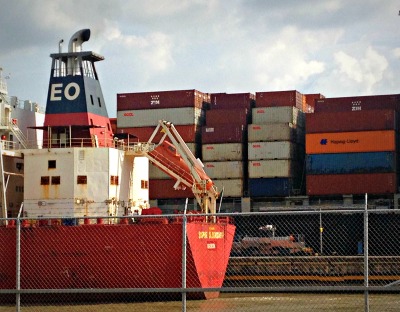
I am particularly interested in ways to keep a shipping container's living space cool, comfortable, and affordable in the tropics.
I recently heard that you can buy a used shipping container in Panama, delivered to your site in Puerto Armuelles, for under $3000.
This price appears to fluctuate widely based on the global economy.
When business is booming, containers are scarce, and thus expensive. When markets are down, there are more abandoned containers since there are fewer goods to be shipped.
As far as shipping containers are concerned, I do have a bit of experience. I have both fixed up a container as a basic living space and visited some high end container living spaces.

A couple of my Seattle designer/builder friends have created “gourmet” shipping container buildings. I have visited those units. So I have experienced how a shipping container can be transformed into an artistic home.
One of my friends, Hartman Kable, created a modernistic take on the surfer “shack” using a shipping container. It has been featured in various magazines, including Make Magazine's video below. The publicity earned Hartman a trip to the east coast to do another similar project for a high end client.
I like that Hartman kept the look of the container. He didn't radically transform the container so that it was hard to see that the base building material was one or more shipping containers.
Hartman gives a tour of his cool container surf shack in Make Magazine's video below. I'd recommend skipping their very long intro and going directly to Hartman's tour at minute 1:25.
[leadplayer_vid id="579B56D30E20D"]
(Note, Hartman built this on the Olympic Peninsula in Washington State, which has a very different climate than Panama does. You would need to add air conditioning to use something like this in Panama.)
When I was commercial fishing in Alaska, I spent 2 summers living in a shipping container. The container was delivered and leveled right next to the cabin of my employer. This was on the bluff above the mouth of the Egegik River on Bristol Bay in SW Alaska.
One of my pre-season projects was to outfit this 40’ container as a combination net shed, work shop, and crew quarters. The remodel had to be simple because of our very limited supply of building materials. We had to use what we had since we were out on the tundra above Bristol Bay, about 200 miles away from Anchorage, .
The container was an insulated refrigerated model with teak paneling and floor. (Note: most containers are not insulated). It cost $1000 at the time, delivered to our site. So it was affordable. Certainly cheaper than building a similar structure out of more typical materials.
In our wide open, cool, windy tundra base camp, the container was perfect. I put a heater in it. I easily stayed warm. I slept very well since I was always exhausted after the days work. (A long day being 20 or 30 hours of fishing without sleep.)
The container was a secure cocoon in an environment where the wind often blew 50 miles an hour. Our summertime high air temperature was usually around 50 degrees Farenheiht, and the water temperature was in the mid to high 40’s. In a word, my container building was “snug”.

Conversely, in our tropical environment here in Puerto Armuelles, “snug” is not a good thing.
If you look at an indigenous tropical hut, what you will observe is a roof and support for that roof. Not much more. There might be some lightly woven mat walls or bamboo to provide some privacy from neighbors, and a little extra shade.
Generally a good building type for the tropics is a lot like an umbrella. Shade, Shade, Shade, plus, protection from the rain.
In a perfect tropical world, walls are not necessary at all. They are a hinderance to air flow and evaporation. We northerners mostly like them, because they afford privacy, and security.
In fact, while Panamanians are often cold at night and in the early morning, most northern immigrants, except in the highlands, do not require walls for warmth. Our need for walls is generally for privacy, security, and in large part, because we grew up in houses with walls. We just think that houses “should” have walls.
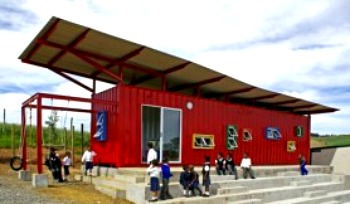
The challenge is how to make a cool and comfortable container house in Panama.
The easiest way to do this is to keep the sun off your container. Solar gain is the biggest factor in hitting up your container home.
A site called containerhomeplans.org specifically discusses what to do to keep your container cool in Panama and elsewhere.
Read more details at containerhomeplans.org here and on this page.
As I have mentioned, ventilation and air flow is a huge factor in keeping living spaces cool. Tropical houses are typically designed to maximize air flow for this reason.
To achieve adequate cooling air flow in a shipping container, requires that you modify the container. One example of what that could look like is seen in the South African classroom photo.
However, if you like the idea of closing up the container as a secure pod, you cannot do that. (Watch the video above to see how Hartman is still able to secure his container using the original container doors.) You will need to use air conditioning. You may even want to use a portable air conditioner so you can safely store the A/C unit inside the container.

Successful Container Housing In Panama
People have been successful in creating container housing in Panama. A couple who created a home using multiple shipping containers near El Valle, Panama. They detailed how they built it in their blog.
It took them 5 years to create their container home (see photo). In the end, the amount of work they did to create their container house means that it is not the cheap and easy option that attracts so many people. They are currently selling their home for more than half a million dollars.
My Opinion
In short, my opinion of shipping container construction in low-land tropics is low. I don't enjoy living in air conditioned spaces with low ceilings. It seems clear that without a tremendous amount of work, that is the type of container house you must live in here.
I don't think using a shipping container is a good option for a pleasant home here in Panama. You can build a much more pleasant Panama house using cement - and it is affordable. You can either use formed and poured, or concrete block (the most common method) for your new home.
Containers do make great tool or other storage, if you can find one at a good price. Keep in mind that, if left in the sun, the interior temperature of a shipping container is likely to reach 160 degrees Fahrenheit. Of course, you can build a roof over your shipping container to provide some protection from the sun.
If anyone has more information, contacts, or websites to share, I am certainly eager to learn more about shipping container construction. I think our readers would also be interested.

Before moving to Panama, I was already quite familiar with bamboo from my travels in Southeast Asia and while building houses in Japan.
In both Hong Kong and mainland China, I have seen bamboo scaffolding rising up 15, even 20 stories. In Indonesia, I've seen bamboo used for construction of airy pole buildings.
My only real bamboo construction experience has been with Tonkin cane from Vietnam. I still have some Tonkin cane stored along the side of my home in Seattle. It is left over from a fence I built 18 years ago.
Tonkin cane is solid, with literally no hollow core.
The bamboo has been stored outdoors in Seattle’s moist and mild climate for 18 years. It appears to have aged hardly at all. The fence that I built from this bamboo is in nearly the same good condition. Though it has been exposed to sun, rain, high and low temperatures for nearly two decades, I have only replaced a couple of canes in all those years.

We get plenty of rain and abundant sunshine here in Panama. It is an ideal combination for bamboo habitat. In fact, some of Panama's timber species grow 20 or 30 feet annually and can reach up to 8” in diameter.
In our town of Puerto Armuelles Panama, you can typically get timber bamboo 60 feet tall and 3”-5” in diameter (see photo).
The price is wonderfully affordable. A 60’ length of timber bamboo only costs ~$1.50. Unfortunately, you wouldn't want to use it to build your home.
This is because Panama's timber bamboo has a mostly hollow structure. Which mean it does not last long when used as the exterior of structures.
Most bamboo that I have encountered in Puerto Armuelles, and generally in Panama, appears to be some strain of fast-growing golden bamboo.
Panama's most common bamboos are prone to dry out and crack in the dry season. It also degrades rapidly when exposed to sunlight and is prone to mold and rot.

As these 2 photos show, the bamboo typically used to build homes in Panama is what is easily grown and harvested here. A fast-growing golden bamboo.
It is not the type of bamboo that North Americans think of as appropriate for construction. That is because it is not. These are not permanent structures. These homeowners know they will need to replace the bamboo in these small houses every few years.

However, sometimes a temporary building structure is just want you need.
We often use timber bamboo as temporary bracing or temporary fencing on our projects. I have made a couple of temporary sheds and a carport with it on our own property or in situations where I am “checking out” a design idea.
Since each 60’ length of timber bamboo costs about $1.50, it is a great, low cost, temporary building material. If it is protected from the sun and rain, the bamboo appears to last several years.
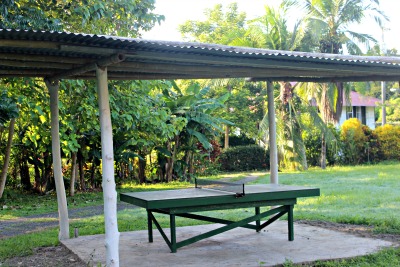
As you can see in the living room photo, we even use it in our own home. The bamboo you see in the photo is about 8 years old. We have replaced the bamboo on top of the zinc roof once in those 8 years. (Note: This open-air living room was added during the remodel, the rest of the house is 2 stories.)
I have seen photos online of beautiful bamboo structures in Costa Rica and other tropical countries.
In fact, I met a German man who has built a Bamboo house just over the border, on the beach in Costa Rica. I have yet to visit his project and find out more about it. I do know that he brought in a builder from a high-end area of Costa Rica who specializes in bamboo construction for expats. It is still on my “to do” list to visit his home and find out what strain of bamboo he used.

There are roughly 1500 known bamboo species on the planet. However, only a hand-full of them can be used for construction.
In Latin America, including Panama, the yellow striped bamboo, Bambusa vulgaris 'Vittata', is everywhere. Sadly, due to its hollow core, it cannot be used for construction.
The best construction-worthy bamboo grown in Latin America is the Guadua Angustifolia. Unfortunately, it is not a popular crop. Teak is much more popular.
People have been growing teak as an income-crop for many years. Until that changes, there likely won't be a much high-quality Guadua Bamboo available in Panama. Because there isn't much of this bamboo for sale, it will cost you more than you probably want to pay.
However, there seems to be sufficient Guadua Bamboo available in nearby Costa Rica (see Rudy's comment in the comment section).
Until it is more widely available in Panama, that may be a good option. You would have to investigate any import taxes you might have to pay to bring the bamboo over the border into Panama.
Of course, you can import the construction grade bamboo you need from various sources.
At least one of the sources I used to write this post (see below), offers to deliver construction grade bamboo to your building site in Panama. My guess is that cost of importing bamboo, relative to other construction materials, will be expensive. But it does seem worth checking out the cost.
The good thing is if more people want to build with Bamboo, more people will produce it, hopefully in Panama. This increase in supply will decrease the cost of bamboo.
Hopefully, building high-quality bamboo construction in Panama will stop being a luxury construction method.
With a greater supply of construction grade bamboo in Panama, bamboo can become an excellent way to build an attractive and affordable eco-friendly house.

Wood is a great way to build in the highlands of Panama, such as in Boquete and Volcan. Or a place where there is a desire for an insulated wall cavity to contain fiberglass insulation. In the highlands, builders are pretty familiar with wood construction methods, so finding good carpenters is possible.
On the warmer coast of Panama, unless you are air conditioning the whole house, the insulative quality of a 2x4 cavity is not of much benefit.
Having adequate ventilation is far more critical in the warmer lowlands of Panama.
Moisture can collect in unventilated wall insulation. This leads to wood rot and provides a breeding ground for unhealthy mold spores.
As I mentioned, a key reason not to build with wood is termites. Termites are more pervasive in Panama's warmer coastal regions than in the highlands. To be fully protected from termites, any wood used in construction needs to be pressure treated with arsenic, or some equivalent insect repellant. This means that the entire wood structure of your homes would be built of a highly toxic, non-environmental safe material.
If this is not an issue for you, chemically-treated wood is available in nearby David. It is usually imported from Canada. Keep in mind, that it is expensive.
You can use locally available hard woods that are naturally more resistant to pests, but they are just resistant, not impervious. You will have to tend to your wood on regular basis by injecting poison where you see evidence of termite infestations. If you don't do that, your house will slowly be eaten from the inside out.
Wood is definitely not a low-maintenance or low-cost building material choice in Panama. For all these reasons above, we are not using wood as our primary construction material in our Living In Panama House.
Keep in mind, whether you build with wood or not, roof insulation as protection against thermal gain from the sun is needed in both the highland and lowlands of Panama. Solar gain is the main source of the excessive heat in the tropics.
Having said all this, if I were to build a two story structure, I would use both concrete and wood. Concrete for the 1st floor and pressure treated 2x’s for the 2nd floor. The upper floor would be mostly open air with very little wall.
Costs More to Build & Maintain
A house built with both materials is more costly.
Also, finding skilled carpenters in Panama is more of a challenge than finding skilled masons.
Our family likes the ideas of a multiple story house made of wood and concrete. We are toying with building ourselves a 3 story “tree house” on one of our lots by the beach. Of course, we have to assess how much effort we are willing to put into the endeavor.
We are not the only expats who have chosen to remodel a wood house in Panama. There are a few other expats in Puerto Armuelles who have remodeled one of the 2x4 framed Chiquita Banana houses. I believe each of these owners had a lot of construction experience in the US, prior to moving to Panama. So the wooden houses appeared to be familiar terrain to them.
In each case, the owner-builder ended up either doing much of the carpentry himself or had to train his crew from scratch. This is because the labor pool knew nothing about high quality wood construction. Alternatively, they had to accept a grossly inferior product from an incompetent local carpenter. Most of these projects resulted in a combination of the 3 methods above.
One fellow, who is doing a beautiful job remodeling a house in our neighborhood, has been working on his house for over 3 years, and it is still not finished. This fellow is a superb craftsman and the house project is beautiful. However, from my point of view, it is too much money and too much effort. I have spoken with this guy many times over the course of the project. He has said that he would not attempt the project, if he had it to do over.
Our own situation is not dissimilar, although we did not forge ahead quite so doggedly. Our own wooden Chiquita house remodel is only half finished. After six months or so, I finally just fired the crew.
Today, I don’t think too much about my half finished Chiquita Banana House. If I do think about it, I see 2 possibilities for our home. 1) I will complete the project myself, over time, rather than employ locals to do the finicky carpentry. 2), more likely, we will continue to live in the half-remodeled structure.
Our house works fine as it is. In fact, we love to live in it. It feels sort of like living in a huge, well-ventilated artists loft apartment. We have loads of space (about 3500 square feet on two floors).
Not finishing my wood house remodel allows me the time to focus our construction efforts on our beach properties. As a rough comparison, I estimate that I can build 5 or 6 open air, concrete beach houses in the time that it would take to complete the remodel of our wooden Chiquita Banana House. Plus, I think concrete construction is a lot more fun and a more productive use of my time, money, and creative energy.
If you do decide to use wood to build your house, you may want to go the wood and concrete route. Except for the posts, and ceiling structure, the whole bottom floor of our Chiquita Banana house is made of concrete.
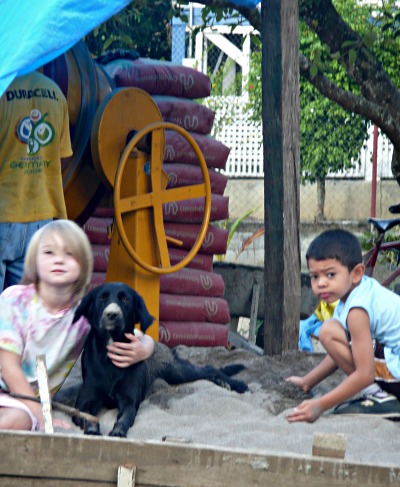
Which is why cement is the typical building material of all of Latin America.
It is also what we use as the primary construction material for our Living in Panama House.
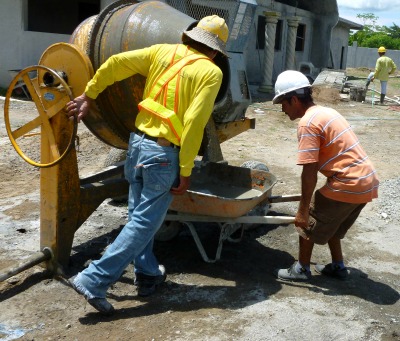
It is wise to keep your construction project within the comfort zone of the local workers. Builders in Panama are most comfortable working with concrete.
Think of Panama as a small town of 100 years ago, where folks are used to doing things the same way, generation after generation. Of course, they can learn new ways, but it won't be a fast, easy, or necessarily successful process.

Concrete block is the most common method of construction. It is usually reinforced with steel rebar and the hollow cells in the blocks are filled with a concrete slurry.
Standard concrete blocks are 16” long and are available in 4” and 6” thicknesses.
Half blocks may be purchased to maintain the overlapping rhythm of the block structure. Block may easily be cut with a grinder, or scored and broken to size. (This is the most common method both in Panama and in North America).
As I mention in another article on hardware stores, the quality of block available in Puerto Armuelles varies greatly from supplier to supplier, and even between batches from the same supplier. You need to inspect each shipment, and even every block. Some blocks literally fall apart in your hands, while others are perfectly adequate, especially if you use plenty of steel reinforcement, and fill all cells with concrete.

Please note: No block that I have encountered in Panama is of the high quality that one would encounter at a typical home center, or concrete supplier in the States or Canada.
However, I believe that in the very near future, as with everything else in Panama, the quality of local block will rise to the level of that in North America. The growth rate and improvements in quality in Panama are like nothing I have seen anywhere in my lifetime. The pace of growth and modernization in Panama is truly astounding.
Custom Blocks In Puerto
Our best block supplier has agreed to provide custom blocks using a higher ratio of cement to aggregates than his standard block. He will make it your specifications.
In other words, we can start getting that higher North American- quality block in Puerto Armuelles today.
M2 or Convintec is a insulated Styrofoam core panel covered with a galvanized steel mesh that is used

primarily for interior and exterior walls and sometimes for flooring or the roof.
M2 is used in place of concrete blocks, but must be “stucco coated” or "repello" with concrete.
M2 is increasingly popular and allows building to go up very quickly. Some people import higher quality M2 panels than are available in Panama. But most are successful using the locally available M2 panels.
M2 panels come in different thickness. Ideally, you should use panels at least 4 inches thick. Panels thinner than 4 inches have a tendency to buckle and are not load bearing.
Plycem is a fiber cement board widely used to replace wood siding, plywood, tile base in showers, and, at times, sheetrock. It can be cut, sanded, nailed, rough dressed, drilled and screwed with conventional woodworking tools.

There is a similar product to Plycem available in the States. It is called Hardiboard.
Benefits of Plycem
Plycem is designed to be screwed into wood or steel studs and floor joists. 3/4 or 1" Plycem can even replace plywood floors, when placed on closely spaced floor framing using steel studs or wood.
In our own house, we have used Plycem as the base for a tiled kitchen floor as well as for the floor and walls of our bathrooms.
Thanks.

I wrote a post about each of these 4 building materials. The links to those posts are at the bottom of this page.
Whatever construction materials you use for your house, you need think about your choice carefully.
Hopefully, the answer is yes to all of the above questions. If not, make sure you are okay with the extra work and/or cost using your chosen material will entail.
One thing you should be careful about, is using building materials or construction techniques with which the local labor is unfamiliar.
If you get too innovative, you are likely to lose the locals along the way. Certainly, they will not be as interested in trying a new building experiment as you, the northern immigrant. You are in for a shock, if you came to Panama with ego-driven notions of how you would build, once you had moved to paradise, and with labor day rates that are less than half of what hourly rates are up north.
For some of us (I include myself here), this will require that we put our own ego in the “back seat." If you don't, you will face a lot of frustration, cost overruns, and disappointing results.
For me, after a long period of trying get the local builders to do things exactly, precisely my way, I have come to the conclusion that it is just not worth it. Believe me, I have tried it, many times (I am a slow learner). It just does not work. Or if it works, it is not a happy experience for anyone.
There are many wonderful things about the Panamanian people. When taken on their own merits, the people of Panama are kind, peaceful, genuinely warm neighbors, and happy to share their beautiful country with us. However, an intrinsic desire to learn something new, from foreigners no less, is not high on their priority list.
It is my opinion that we expats do best when we accept that fact. When we don’t try to impose our own perfectionism and rigid views upon the locals. Our own culture has certainly made plenty of mistakes, and continues to make mistakes and on a global scale.
Maybe we are being offered this opportunity to compromise a bit, to be less perfectionistic and judgmental . With this attitude well in mind, you can produce an interesting, good quality, project. A project that you can be proud of. And most importantly, you will build your house in a way that will not make enemies of your new Panamanian friends. Those relationships will be a joy for years to come.
July 16, 2016

UPDATE: Del Monte now has full legislative approval to grow bananas in Puerto Armuelles & Baru.
A big crowd had gathered in ESPA's high school gymnasium to hear the news. The Panamanian Minister of the Presidency, Alvaro Aleman, and other officials signed documents.
There was a very long speech by the mayor of Puerto Armuelles, Franklin Valdez, followed by a not-quite-as-long speech by Alvaro Aleman. Nothing surprising was said. Alot of talk of jobs, economic recovery, and how hard they are working to get an agreement with Del Monte to revive the banana industry in the Baru district of the Chiriqui province.
Alvaro Aleman told the crowd that the first step towards reviving the banana industry in Baru was to sign an agreement with Del Monte. However, that agreement must be approved by the Council of Ministers and then ratified by the Panama National Assembly.
"I am confident that this bill, which will be presented in this legislative period, will be passed so that next summer Del Monte can begin its investments in the area," said Aleman.
The minister said that if approved, Del Monte could make up to $220 million in investments in the Baru plantations which will provide, "important sources of work."
He also explained that one of the outstanding issues is how and whether to allow Del Monte to buy the plantations since some of them are within 10 kilometers of the border. The Panama Constitution prohibits foreigners from owning land within 10 kilometers of the border.
Del Monte is interested in acquiring "approximately 2,572 hectares belonging to the State, 840 hectares owed by an agricultural association, and 1,771 hectares that are privately owned." said Aleman.
Varela visits in September & updates Del Monte progress
The atmosphere of the crowd was one of muted and wary optimism. While much was made of the signing of documents, it was only another step in the long process of getting a banana company in Puerto Armuelles. The current talks with Del Monte have been going on for more than a year so far.
Progress has been made. Del Monte has asked to be allowed to hire foreign labor, but it was agreed that they would follow Panama labor laws, which makes bringing in foreign labor very difficult.
There is another company that wants to take over banana production in the plantations in the District of Baru. About a year ago, Coobana, a worker's cooperative also expressed interest in taking over the banana plantations in the Puerto Armuelles area. That proposal was not mentioned during yesterday's meeting.
2 banana worker cooperatives started in the wake of Chiquita pulling out (in Puerto Armulles) and greatly scaling back (in Bocas del Toro). Puerto Armuelles's worker cooperative, Coosemupar, was a dismal failure for many reasons.
On the other hand, Bocas's cooperative, Coobana, continues to be a success. Their success is credited to the critical and successful overture Coobana made to supply bananas to Europe. Coobana has had to modify many of its labor and growing practices to comply with European standards.
Given that the Minister of President of Panama was here to announce further progress in negotiations with Del Monte, Coobana coming to Puerto seems unlikely. However, I think a company run by other Panamanian banana workers would be a good choice for Puerto. Especially a company that has improved both labor practices and safe growing methods.
I am not sure of all the details of the proposal of either Del Monte or Coobana though. I have heard some say that Coobana has already taken over some of the plantations in Baru. Perhaps those are the lands mentioned above that are owned by an "agricultural association". Accurate information can be hard to get in Panama.
For now we will have to wait and see what develops. I know that the owners of Puerto's newest restaurant, Cafe del Mar, are looking forward to a new banana company and the influx of money into the pockets of Portenos.
Enjoy the photo gallery of yesterday's Del Monte meeting. Click on any photo to start the slideshow.